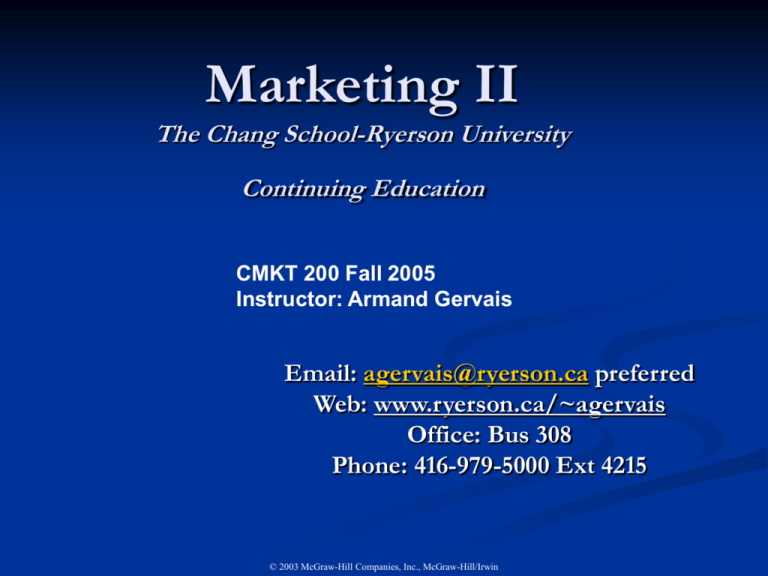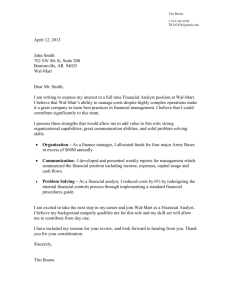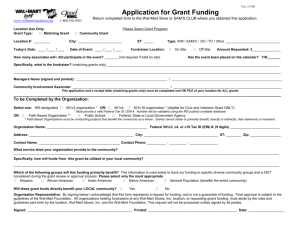Lecture 2 Global Marketing
advertisement

Marketing II The Chang School-Ryerson University Continuing Education CMKT 200 Fall 2005 Instructor: Armand Gervais Email: agervais@ryerson.ca preferred Web: www.ryerson.ca/~agervais Office: Bus 308 Phone: 416-979-5000 Ext 4215 © 2003 McGraw-Hill Companies, Inc., McGraw-Hill/Irwin Lecture 2 Agenda Don’t Forget Name Tags Global Marketing Video Wal-Mart Break Discussion Video Simulation To Do’s for next weeks class Time to work in Groups REACHING GLOBAL MARKETS NOW THE WORLD CAN BREATHE EASIER…ONE NOSE AT A TIME Breathe Right Worldwide success DYNAMICS OF WORLD TRADE World Trade Flows Global perspective FIGURE 7-1 Illustrative world trade flows for manufactured goods and commodities (billions of dollars) DYNAMICS OF WORLD TRADE Global perspective (cont) Countertrade Trade feedback effect United States perspective Gross domestic product Balance of trade Competitive Advantage of Nations DYNAMICS OF WORLD TRADE Competitive Advantage of Nations Factor conditions Demand conditions Related supporting industries Company strategy, structure, and rivalry Economic Espionage FIGURE 7-2 Porter’s “diamond” of national competitive advantage Concept Check 1. What is the trade feedback effect? A: The phenomenon in which a country’s imports affect its exports and vice versa. Concept Check 2. What variables influence why some companies and industries in a country succeed globally while others lose ground or fail? A: Factor conditions; demand conditions; related and supporting industries; and company strategy, structure, and rivalry. EMERGENCE OF A BORDERLESS ECONOMIC WORLD Decline of Economic Protectionism FIGURE 7-3 How protectionism affects world trade EMERGENCE OF A BORDERLESS ECONOMIC WORLD Decline of Economic Protectionism (cont) Tariffs Quota World Trade Organization Rise of Economic Integration European Union FIGURE 7-4 The countries of the European Union in 2002 Map of Euro Countries Euro Coins and Currency 1 Euro Coin (Common Side) 5 Euro Bank Note (Common Side) 1 Euro Coin (Greek) 5 Euro Bank Note (French) EMERGENCE OF A BORDERLESS ECONOMIC WORLD Rise of Economic Integration (cont) North American Free Trade Agreement Asian Free Trade Agreements EMERGENCE OF A BORDERLESS ECONOMIC WORLD A New Reality: Global Competition among Global Companies for Global Customers Global Competition Strategic alliances EMERGENCE OF A BORDERLESS ECONOMIC WORLD A New Reality: Global Competition (cont) Global Companies Multidomestic marketing strategy Global marketing strategy Global Consumers Emergence of Networked Global Marketplace Diet Pepsi Ad Brazil The Global Teenager 500 million consumers Concept Check 1. What is protectionism? A: It is the practice of shielding one or more sectors of a country’s economy from foreign competition through the use of tariffs or quotas. Concept Check 2. The North American Free Trade Agreement was designed to promote free trade among which countries? A: United States, Canada, and Mexico Concept Check 3. What is the difference between a multidomestic marketing strategy an a global marketing strategy? A: A multidomestic marketing strategy means that firms have as many different product variations, brand names, and advertising programs as countries in which they do business. A global marketing strategy standardizes marketing activities when there are cultural similarities and adapts them when cultures differ. A GLOBAL ENVIRONMENTAL SCAN Cultural Diversity Cross-cultural analysis Values Customs Foreign Corrupt Practices Act Cultural Symbols Semiotics Eiffel Tower Cultural lessons for Coca-Cola Parthenon Cultural lessons for Coca-Cola A GLOBAL ENVIRONMENTAL SCAN Cultural Diversity (cont) Language Back translation Cultural ethnocentricity Consumer ethnocentrism A GLOBAL ENVIRONMENTAL SCAN Economic Considerations Stage of Economic Development Economic Infrastructure Consumer Income and Purchasing Power Coca-Cola in Russia Financial investments in bottling and distribution FIGURE 7-5 How purchasing power differs around the world A GLOBAL ENVIRONMENTAL SCAN Economic Considerations (cont) Currency exchange rates A GLOBAL ENVIRONMENTAL SCAN Political-Regulatory Climate Political Stability Trade Regulations Checking Political Risk Ranking favorable business climates Concept Check 1.Semiotics involves the study of ________________________ cultural symbols and their ________________________ role in the assignment of ________.for people meaning Concept Check 2. When foreign currencies can buy more Canadian dollars, are Canadian products more or less expensive for a foreign consumer? A: Less expensive. GLOBAL MARKET-ENTRY STRATEGIES FIGURE 7-6 Alternative global marketentry strategies GLOBAL MARKET-ENTRY STRATEGIES Exporting Licensing Joint Venture Direct Investment Creative Cosmetics in Japan Creative Export Marketing McDonald’s in Moscow, Russia McDonald’s in Moscow, Russia Customers Waiting Outside Customers Eating Inside Concept Check 1. What mode of entry could a company follow if it has no previous experience in global marketing? A: Indirect exporting through intermediaries. Concept Check 2. How does licensing differ from a joint venture? A: In licensing, the firm offers the right to a trademark, patent or trade secret, in return for a fee or royalty. In a joint venture, a foreign and a local firm to produce some product or service. The two companies share ownership, control, and profits of the new entity. CRAFTING A WORLDWIDE MARKETING EFFORT Product and Promotion Strategies Product extension Product adaptation Product invention FIGURE 7-7 Five product and promotion strategies for global marketing CRAFTING A WORLDWIDE MARKETING EFFORT Distribution Strategy Gillette in Greece Same global message Gillette in Germany Same global message Gillette in United States Same global message FIGURE 7-8 Channels of distribution in global marketing CRAFTING A WORLDWIDE MARKETING EFFORT Pricing Strategy Dumping Gray market Concept Check 1. Products may be sold globally in three ways. What are they? A: Product extension, product adaptation, and product invention. Concept Check 2. What is dumping? A: Dumping is when a firm sells a product in a country below its domestic price or below its actual cost. Is Wal-Mart Good For America http://www.pbs.org/wgbh/pages/frontline/shows/walmart/view/ © 2003 McGraw-Hill Companies, Inc., McGraw-Hill/Irwin Wal-Mart Facts 100 million: The number of people who shop at Wal-Mart's 3400 American stores every week. 50 million: The amount of square footage Wal-Mart plans to add this year, including 50-55 new Wal-Mart stores, 220-230 new Supercenters, 35-40 new Sam's Club and 130-140 new international stores. [View a chart of Wal-Mart locations worldwide, as of Jan. 31, 2004.] 1.2 million: The number of Wal-Mart associates in the U.S. Any full- or part-time Wal-Mart employee, up to and including the CEO, is considered an "associate," in Wal-Mart parlance. Internationally, Wal-Mart employs an additional 330,000 associates. 600,000: The number of new employees Wal-Mart hires each year. The company's turnover rate is 44 percent -close to the retail industry average. 1979: The year Wal-Mart's sales first top $1 billion. $256 billion : Wal-Mart's sales in 2003. In the words of Wal-Mart CFO Tom Schoewe, Wal-Mart's sales are equal to "one IBM, one Hewlett Packard, one Dell computer, one Microsoft and one Cisco System -- and oh, by the way, after that we got $2 billion left over." 35: The number of Wal-Mart Supercenters in China. $15 billion: The amount of Chinese products Wal-Mart estimates it imports each year; others suggest the number may be higher. $120 billion: The U.S. trade deficit with China in 2003. 8 percent: The amount of total U.S. retail sales, excluding automobiles, accounted for by Wal-Mart. $9.98: The average full-time hourly wage for a Wal-Mart employee. The average full-time hourly wage in metro areas (defined as areas with a population of 50,000 or more) is $10.38. In some urban areas it is higher: $11.03 in Chicago, $11.08 in San Francisco, and $11.20 in Austin. To Do’s for Next Class Before you leave today sign attendance sheet Email me your contact information Student ID, Email, and contact number Please include a little about yourself: Program, Major, work experience etc. Complete the assigned readings download through library Form teams and review simulation www.marketplace6.com © 2003 McGraw-Hill Companies, Inc., McGraw-Hill/Irwin



